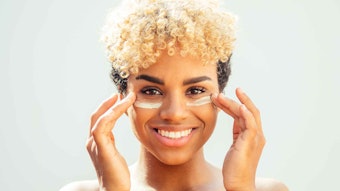There is a constant stream of innovation in anti-aging formulations, as manufacturers respond to increasing consumer demand for new ways to defy the visible signs of aging. At in-cosmetics 2013, the Anti-ageing Workshop will address the latest trends in ingredients as well as look at other factors, such as the difference between Asian and Caucasian skin. Gabrielle Sore, scientific communication director of skin care for L'Oréal Research and Innovation, will be presenting as part of this workshop, and here she shares her thoughts on skin aging and the ingredients and techniques available to formulators that deliver new and more effective skin care products.
C&T: How can skin care products better address aging?
There are several approaches to better address skin aging with a skin care product. It depends on which population age groups and ethnic groups the formulator is targeting. In fact, signs of visible aging are different for people in their 30s vs. people in their 50s. on the other hand, there are also aging differences between Asian, Hispanic, Caucasian and African skin. In addition to the biological modifications in skin aging, the expectations of the consumer must be carefully taken into account. One approach is to prevent with sunscreens, moisturizers and antioxidants, etc. Another approach is to repair or restore with molecules like Pro-xylane (INCI: Hydroxypropyl Tetrahydropyrantriol), a biomimetic active ingredient originally developed by Lancome that induces and stimulates dermal and epidermal glycoaminoglycans and participates in reinforcing the dermal-epidermal junction. Annother example is LR2412, a “jasmonate” also developed by Lancome that acts on each level of the skin to aid in the fight against wrinkles, pore enlargement and other skin imperfections. Furthermore, to better address skin aging, skin care products can also be combined with devices or instrumental cosmetics, which permit to complete treatments at home.
C&T: Can one product address all signs of visible aging?
Thanks to recent research in skin biology, skin care products are addressing a wide range of visible signs. Now, formulators can create products with a combination of active ingredients that have complementary efficacies. Whichever population is targeted, products must not only fight against skin aging but must also provide preventive efficacy by integrating protective ingredients like UV filters into a day cream.
On the other hand, especially when getting old, more and more women use more than one skin care product. In fact, they like to combine their day and/or night cream with a serum, which has a light texture and is quickly absorbed into the skin. In some cultures, women can include up to five to six skin care products in their daily beauty routine. This is what happens in Japan and Korea, where people are well known for their sophistication. In Japan, after a cleansing routine (which takes place morning and evening), women apply a cosmetic water, an essence, a milky lotion, a cream and a UV filter cream successively on their face during their morning routine. Each product has its own sensorial code or texture according to the season. Sometimes, they also include a mask. In the morning, after using all these products, they continue with a sophisticated makeup routine. On top of this elaborate skin care routine, prevention is a strong concept in Japan, which explains why women start using skin care products before their 20s and try to avoid the development of dark spots, dehydration and aging.
C&T: What ingredients have been shown efficacious to treat skin pigmentation, wrinkles or sagging?
It is impossible to mention all ingredients; they are too numerous. However, some of them are ubiquitous like vitamin C or retinol. Nevertheless, whatever the ingredient is, it is essential that it remains stable in the product and is not degraded into an ineffective ingredient or worse into a toxic ingredient. Moreover, its efficacy has to be proven not only through in vitro tests but also through in vivo tests under clinical supervision.
Ultimately, it is the consumer who evaluates the efficacy of her/his product and appreciates the skin benefits. To treat pigmentation, the approach can be inspired from dermatological approaches. Until recently, formulators focused on anti-tyrosinase, antioxidant and exfoliating active ingredients. Now, we know that the superficial dermis must also be targeted, photo-aged papillary fibroblasts being more prone to induce darker coloration than young papillary fibroblasts. To treat wrinkles, there are several and complementary approaches: exfoliation, stimulation of epidermal renewal, restoration of extracellular matrix, reinforcement of dermal-epidermal junction, etc..
C&T: What are some new targets for cosmetic products?
There are several contributors to aged skin appearance. We will focus on four recent insights related to skin aging: the superficial dermis, the gene expression, the regenerative potential of stem cells and the skin glycobiology. Accounting for the clinical, histological and molecular characteristics of the superficial dermis make the upper part of the skin a key target.
The dynamics of gene response is a true signature of biological aging, far more accurate than chronological aging. Skin stem cells and their immediate micro-environment must be protected for life long benefits. Finally, carbohydrates can be considered as carriers of skin biological information and organization.
C&T: How can these targets be tested to show their efficacy?
Several tools are available. These targets can be studied by tools like reconstructed skin, “omics,” immuno-histochemistry and biphotonic microscopy. They permit the identification of biological modifications and new biological targets for cosmetic products. They should be completed by in vivo tests to support whether these efficacies are recognized by clinicians and consumers.
C&T: What is on the horizon of anti-aging skin care?
Ideally, there could be anti-aging skin concerns that can improve the consumer's skin in a similar fashion to dermatological procedures without any adverse reactions. Until the industry reaches this goal, there is research on new materials that can modify skin surface appearance with an immediate effect. New instrumental device development, like light technology therapies, is also a promising approach to complete the anti-aging efficacy of skin care products. Discovery of new molecules or new activities on skin rejuvenation will continue not only for topical applications but also for dietary supplementations. Nowadays, there are some pills (containing hesperidin, antioxidants, etc.) that help the skin gain more elasticity or benefit from an improved protection from external aggressions. Furthermore, prevention will certainly be a developing area in the future, and the discovery of new environmental factors that could potentially accelerate skin aging should help.










